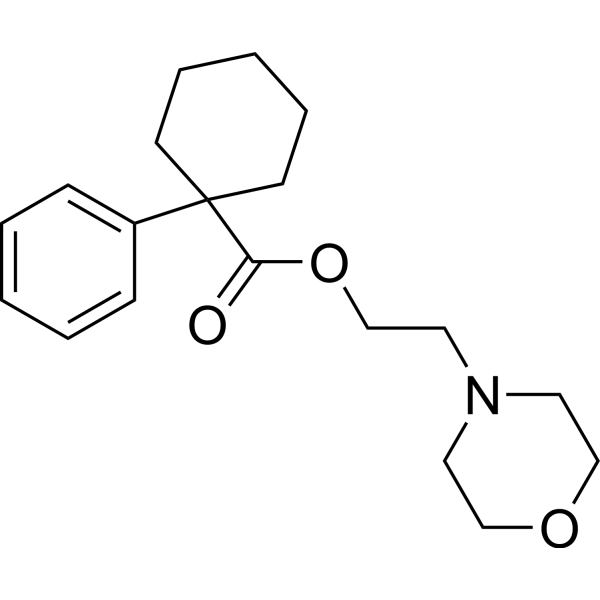PRE-084 hydrochloride
Modify Date: 2024-01-02 15:34:59

PRE-084 hydrochloride structure
|
Common Name | PRE-084 hydrochloride | ||
|---|---|---|---|---|
| CAS Number | 138847-85-5 | Molecular Weight | 317.42 | |
| Density | 1.103g/cm3 | Boiling Point | 446.6ºC at 760mmHg | |
| Molecular Formula | C19H27NO3 | Melting Point | N/A | |
| MSDS | N/A | Flash Point | 223.9ºC | |
Use of PRE-084 hydrochloridePRE-084 is a highly selective σ1 receptor (S1R) agonist, with an IC50 of 44 nM. PRE-084 exhibits good neuroprotective effects, can improve motor function and motor neuron survival in mice. PRE-084 also can ameliorate myocardial ischemia-reperfusion injury in rats by activating the Akt-eNOS pathway[1][2][3][4]. |
| Name | 2-morpholin-4-ylethyl 1-phenylcyclohexane-1-carboxylate |
|---|---|
| Synonym | More Synonyms |
| Description | PRE-084 is a highly selective σ1 receptor (S1R) agonist, with an IC50 of 44 nM. PRE-084 exhibits good neuroprotective effects, can improve motor function and motor neuron survival in mice. PRE-084 also can ameliorate myocardial ischemia-reperfusion injury in rats by activating the Akt-eNOS pathway[1][2][3][4]. |
|---|---|
| Related Catalog | |
| In Vitro | PRE-084 (0.1-100 µM; 24 h) protects cultured cortical neurons against β-amyloid toxicity (maximally neuroprotective at 10 µM) and reduces the levels of proapoptotic protein Bax at 10 µM[1]. Cell Viability Assay[1] Cell Line: Cortical cells (βAP(25-35)-induced neurotoxicity model) Concentration: 0.1-100 µM Incubation Time: 24 h Result: Reduced neuronal toxicity in a bell shaped-manner and is maximally neuroprotective at 10 µM. Western Blot Analysis[1] Cell Line: Cortical cells (βAP(25-35)-induced neurotoxicity model) Concentration: 10 µM Incubation Time: 24 h Result: Reduced the levels of proapoptotic protein Bax in cortical neurons induced by βAP(25-35). |
| In Vivo | PRE-084 (0.25 mg/kg; i.p.; 3 times a week for 8 weeks) displays beneficial effects on motor performance (improves motor neuron survival, ameliorates paw abnormality and grip strength performance) in wobbler mice, and shows neuroprotective effects (increases the levels of BDNF in the gray matter)[2]. PRE-084 (1 mg/kg; i.p.; single) protects the heart by activating the Akt‑eNOS pathway in myocardial infarction model[3]. Animal Model: Wobbler mice (4-week-old)[2]. Dosage: 0.25 mg/kg Administration: Intraperitoneal injection; 3 times a week for 8 weeks. Result: Significantly improved ameliorated paw abnormality from week 4, and notably improved paw grip strength at week 5. Reduced the number of reactive astrocytes whereas increased the number of pan-macrophage marker CD68-positive cells and CD206+ cells involved in tissue restoration. Showed 26.5% increase in the mean number of large-size NISSL-positive motor neurons. Animal Model: Adult male Sprague‑Dawley rats (220-250 g; myocardial infarction model)[3]. Dosage: 1 mg/kg Administration: Intraperitoneal injection; single. Result: Significantly decreased the degree of myocardial apoptosis. Led to significantly increased expression of p‑Akt and p‑eNOS. |
| References |
| Density | 1.103g/cm3 |
|---|---|
| Boiling Point | 446.6ºC at 760mmHg |
| Molecular Formula | C19H27NO3 |
| Molecular Weight | 317.42 |
| Flash Point | 223.9ºC |
| Exact Mass | 353.175781 |
| PSA | 38.77000 |
| LogP | 3.50380 |
| Vapour Pressure | 3.61E-08mmHg at 25°C |
| Index of Refraction | 1.532 |
| Storage condition | -20℃ |
| Tocris-0589 |
| Pre 084 |
| 2-(4-Morpholinyl)ethyl 1-phenylcyclohexanecarboxylate hydrochloride (1:1) |
| 1-phenyl-cyclohexanecarboxylic acid 2-morpholin-4-yl-ethyl ester |
| Lopac-P-2607 |
| 2-(Morpholin-4-yl)ethyl 1-phenylcyclohexanecarboxylate hydrochloride (1:1) |
| Cyclohexanecarboxylic acid, 1-phenyl-, 2-(4-morpholinyl)ethyl ester, hydrochloride (1:1) |
| PRE-084 hydrochloride |